 Deaths
which occurred on a March 20: Deaths
which occurred on a March 20:
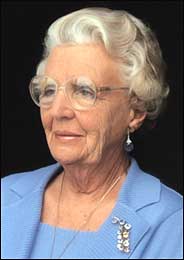 2004
Juliana
Louise Emma Marie Wilhelmina of the Netherlands [< photos >],
of pneumonia (also apparently Alzheimer since at least 2001), born on 30
April 1909, former queen (04 Sep 1948 - 30 Apr 1980) who took the title
of Princess after abdicating in favor of her daughter Beatrix
[31 Jan 1938~]. Juliana and her husband, Prince
Bernhard [29 Jun 1911~], a German, and their two oldest daughters, then
infants, were forced to flee in a truck, then by ship, to England after
the Nazi army treacherously invaded The Netherlands on 10 May 1940, when
her mother Wilhelmina
[31 Aug 1880 – 28 Nov 1962; queen 23 Nov 1890 - 04 Sep 1948] was still
queen. The family spent much of the war in Canada and returned to a devastated,
impoverished country at the end of the war. Among her first acts as a young
queen was not only overseeing reconstruction at home, but also dealing with
conflicts in the Dutch colony of Indonesia. She handed back sovereignty
to the Indonesians on 27 December 1949. On 18 February 1947, Marijke
Christina, her youngest daughter, was born almost blind. Juliana blamed
herself because she had contracted German measles just before giving birth.
With doctors saying they could do little, she turned to a faith healer.
Her close relationship with Greet
Hofmans [23 Jun 1894 – 16 Nov 1968], the healer — who was a militant
pacifist and had a penchant for the occult — became a scandal and nearly
led to the breakup of the royal marriage. The prince contended that the
healer had a dangerous influence on his wife and, after a political furor,
ensured that all contacts between the two women were broken. Queen Juliana,
in turn, stood by her husband during several scandals in which he was involved.
Prince Bernhard was often linked to extramarital relationships, which were
treated as a public secret within the royal family and in some of the Dutch
and European press. But the greater upset to her reign occurred in 1976,
when the government disclosed that Prince Bernhard was involved in a bribery
scandal and had accepted "dishonorable offers and favors" from the Lockheed
Corp., which was eager to sell aircraft to the Dutch military. The prince,
by many accounts, was spared criminal prosecution because of public sympathy
for Queen Juliana's plight. The distraught queen privately told the government
she would abdicate. Fearing a constitutional crisis and a public outcry,
the government merely stripped the prince of his military, charitable and
diplomatic tasks. [brief
illustrated biography] [06
Sep 1948 Time cover] 2004
Juliana
Louise Emma Marie Wilhelmina of the Netherlands [< photos >],
of pneumonia (also apparently Alzheimer since at least 2001), born on 30
April 1909, former queen (04 Sep 1948 - 30 Apr 1980) who took the title
of Princess after abdicating in favor of her daughter Beatrix
[31 Jan 1938~]. Juliana and her husband, Prince
Bernhard [29 Jun 1911~], a German, and their two oldest daughters, then
infants, were forced to flee in a truck, then by ship, to England after
the Nazi army treacherously invaded The Netherlands on 10 May 1940, when
her mother Wilhelmina
[31 Aug 1880 – 28 Nov 1962; queen 23 Nov 1890 - 04 Sep 1948] was still
queen. The family spent much of the war in Canada and returned to a devastated,
impoverished country at the end of the war. Among her first acts as a young
queen was not only overseeing reconstruction at home, but also dealing with
conflicts in the Dutch colony of Indonesia. She handed back sovereignty
to the Indonesians on 27 December 1949. On 18 February 1947, Marijke
Christina, her youngest daughter, was born almost blind. Juliana blamed
herself because she had contracted German measles just before giving birth.
With doctors saying they could do little, she turned to a faith healer.
Her close relationship with Greet
Hofmans [23 Jun 1894 – 16 Nov 1968], the healer — who was a militant
pacifist and had a penchant for the occult — became a scandal and nearly
led to the breakup of the royal marriage. The prince contended that the
healer had a dangerous influence on his wife and, after a political furor,
ensured that all contacts between the two women were broken. Queen Juliana,
in turn, stood by her husband during several scandals in which he was involved.
Prince Bernhard was often linked to extramarital relationships, which were
treated as a public secret within the royal family and in some of the Dutch
and European press. But the greater upset to her reign occurred in 1976,
when the government disclosed that Prince Bernhard was involved in a bribery
scandal and had accepted "dishonorable offers and favors" from the Lockheed
Corp., which was eager to sell aircraft to the Dutch military. The prince,
by many accounts, was spared criminal prosecution because of public sympathy
for Queen Juliana's plight. The distraught queen privately told the government
she would abdicate. Fearing a constitutional crisis and a public outcry,
the government merely stripped the prince of his military, charitable and
diplomatic tasks. [brief
illustrated biography] [06
Sep 1948 Time cover]
2004 Fatma al-Jaled,
8, Palestinian girl, of wounds sustained from alleged “warning shots”
fired by Israeli troops in the Gaza Strip refugee camp of Khan Yunis a day
earlier.
2003 Keith Bernard Clay, 35, by lethal injection
in Texas, for killing convenience store clerk Melathethil Tom Varughese
during a 04 January 1994 robbery in Baytown, near Houston. He is the 300th
executed in Texas since it resumed the death penalty in 1983.
2003
Muhammad Ali Nassir, 54, from Yemen where he has 2 wives and 12
children, shot in the head from half-a-meter away by a Black, at 10:15 (15:15
UT) as Nassir was sitting in his place of work, the Stop II Food Market
in Brooklyn's Crown Heights at 1291 Eastern Parkway. The gunman then fires
repeatedly through a slot in the Plexiglas security window at the counter,
critically injuring with 3 bullets another worker, Yakoob Aldailam, 20,
nephew of the owner. The gunman leaves without trying to rob the store,
whose security cameras had stopped working a month earlier. After Larme
Price, 30, admits on the phone to the police that he committed this and
3 previous similar murders (John Freddy and Sukhjit Khajala on 08 February
2003, and Albert Kotlyar on 10 March 2003) out of anger about the 11 September
2001 attack on the World Trade Center, he is arrested on 29 March 2003.
2002 Elizabeth “Betty” Wettermark Carlson, 87.
A lifelong resident of El Paso, Texas, Betty is survived by her husband
of 44 years (his 2nd marriage, after the death of his first wife), Edward
E. Carlson, 86 (3021 Harrison Avenue, phone 566-0332); son, David E. Carlson,
of Houston, TX; daughter, Sylvia Evans of El Paso, TX; granddaughter, Michelle
Evans of Dallas, TX; grandson, Jon Michael Evans and wife, Genna Evans,
of Houston, TX: several nieces and nephews including Frank Wesster of Peoria,
AZ; and many grandnieces and nephews, not to mention her blind dog, and
a number of alley cats which come through the cat-door in her garage to
eat the food she and her husband put out for them.
2002 Rafael
Jaimes Torra, tesorero de la Unión Sindical Obrera, asesinado en
la noche cuando salía de su residencia ubicada en el Barrio Galán en la
ciudad de Barrancabermeja, Colombia. En el atentado resulta gravemente herido
Germán Augusto Corzo García, sobrino del sindicalista.
2002
Four Israeli soldiers: Warrant Officer Meir Fahima, 40, from Hadera; Staff
Sergeant Shimon Edrei, 20, from Pardes Hannah; Sergeant Michael Altfiro,
19, from Pardes Hannah; Corporal Aharon Revivo, 19, from Afula; two Israeli
civilians: Alon Goldenberg, 27, from Tel Aviv, Maharto Mogus, 75; an unidentified
because disfigured victim; and Ra'afat Tahsin Salim Diab, 20, Islamic
Jihad suicide bomber from Jenin, West Bank, at about 07:05, in Egged 823
line bus on Highway 65 at Musmus junction, near Umm al Fahm, Arab village
south of Afula, Israel. 18 passengers are wounded seriously enough to remain
hospitalized overnight. This brings the al-Aqsa intifada body count to 1218
Palestinians and 359 Israelis.
2001 Vera Lawrence,
53, from breathing difficulties suffered after an attempt, at her home,
by a fly-by-night operator to enlarge her buttocks by injecting either silicon
or collagen. She was an employee in Miami-Dade County's community development
division.
2001 E.C. Mullins, sheriff of
Simpson County, Mississippi.
Sheriff
Mullins died at about 07:30 after being overpowered by a man he was
attempting to question. He had responded to a disturbance call when
the suspect apparently overpowered him, causing him to suffer a massive
heart attack. The suspect then stole his cruiser, with Sheriff Mullins
still inside drove to a service station, stole two cases of beer,
and then returned home. After locating the suspect a SWAT team was
able to take him into custody. Sheriff Mullins' death was ruled a
homicide. Sheriff Mullins is the second sheriff killed in Simpson
County. in the past 10 years. Mullins was elected sheriff in January
2000, but he had served the county for many years. |
2001 Un concejal socialista de Lasarte (España) es asesinado
por la banda terrorista ETA (Euskadi Ta Askatasuna).
1998
Agustín Gómez Arcos, escritor y dramaturgo español.
1995
Twelve die from poison gas attack in Tokyo subway
^top^
In Tokyo, Japan, at the height of the
morning rush hour, five two-man terrorist teams from the Aum Shinrikyo
religious cult, riding on separate subway trains, converge at the
Kasumigaseki station and secretly release lethal sarin gas into the
air. The well-dressed terrorists hastily exit the station, take sarin
antidotes, and disperse to Aum safe houses. As they escape, commuters
are blinded and rush to the exits vomiting and gasping for air. Twelve
people eventually die, and over five thousand people are treated in
hospitals, many still in a coma state. Most eventually recover, but
some suffer permanent damage to their eyes, lungs and digestive systems.
A US Senate subcommittee later
estimated that if the sarin gas had been used and disseminated more
effectively at Kasumigaseki station, a hub of the Tokyo system, tens
of thousands might have been killed.
The
Aum Shinri Kyo, or "Supreme Truth," cult had thousands of followers
all over Japan who believed in its doomsday prophecies. Taking over
the personal assets of new cult members, the Supreme Truth had well
over $1 billion stashed away. Shoko Asahara, a 40-year-old blind man,
was the leader of the cult. His books included claims that he was
the Second Coming of Jesus Christ and that he had the ability to travel
through time.
Japanese authorities
raided Supreme Truth compounds across the country, but could not find
Asahara. At one camp at the base of Mt. Fuji, police found tons of
the chemicals used to produce Sarin gas. They also found plans to
buy nuclear weapons from the Russians. The police eventually located
Hideo Murai, another of the cult’s top leaders, but when he was being
taken into custody he was stabbed to death by an assassin who blamed
Murai for the poison gas attack. Shortly after, the police found a
hidden basement at the Mt. Fuji compound where other cult leaders
were holed up, including Masami Tsuchiya, a chemist who admitted to
making the Sarin gas. Still, Asahara remained at large and the Supreme
Truth carried out four additional gas attacks on subways, injuring
hundreds more. Another potentially deadly chemical bomb was defused
in a subway restroom. A taped video message from Asahara claimed that
US troops had sprayed Mt. Fuji with nerve gas. And, to add to the
unrest in Japan, the nation’s top police officer was shot by a masked
terrorist.
Two days after the
gas attack, Japanese police and soldiers raid Aum Shinrikyo headquarters
and hundreds of Aum members are arrested, including the cult’s blind
leader, Matsumoto Chizuo, 40, who is known as Shoko Asahara to his
followers.
During the 1980s,
Chizuo, a self-styled Buddhist monk, begin winning numerous converts
to his Aum Shinrikyo cult, a Japanese name that translated to the
"True Teachings of Om." In 1989, Aum was recognized as a religious
body and corporation in Japan, and, by 1995, had a worldwide following
of 50'000 people and assets in excess of one billion dollars.
In the early 1990s, Chizuo adapted
Christian Apocalyptic beliefs to his Buddhist teachings, and proclaimed
that he was the reincarnation of Jesus Christ. During this time, Aum
became militant, stockpiling weapons and biological weapons for the
coming Armageddon, and over a dozen political opponents to the cult
were murdered.
On 27 June 1994,
in Matsumoto, west of Tokyo, Aum members released sarin gas in a parking
lot across the street from a rest house where judges who were hearing
a case against them were staying. Seven people died and 150 persons
were injured. However, Japan’s authorities, hindered by constitutional
protection of religious organizations, failed to arrest Chizuo or
suppress his cult.
In early 1995,
he told his followers that World War III had begun, and a second sarin
attack was planned for the Tokyo subway system, which carries four
million riders a day.
In the
years since the 1995 attack, five Aum members have been sentenced
to die for the murderous acts committed by the cult at Kasumigaseki
station and elsewhere, and others have been sentenced to varying prison
terms. The trial of Shoko Asahara, who faces 17 counts of murder and
attempted murder, continues today and may drag on for another 15 years
due to the slow pace of Japan's judicial system.
Aum Shinrikyo was stripped of its legal status and tax privileges
as a religious organization, but the Japanese government concluded
it was no longer a threat and stopped short of using an anti-subversion
law to ban it. Aum has changed its name to Aleph, which is the first
letter of the Hebrew alphabet and meant to signify renewal, and maintains
an impressive following. |
1991 Conor Clapton, 5, son of Eric Clapton, falls out of
53rd floor window.
1990 Victor Rothschild, financiero
francés.
1983 Ivan
Matveevich Vinogradov, Russian mathematician born on 14 September
1891. He used trigonometric series to attack deep problems in analytic number
theory.
1978 Barbara Williams, stabbed, in El Paso,
Texas. The murderer is not discovered, at least during the next 26 years.
1974 Chet Huntley, 62, newscaster (NBC Huntley-Brinkley
Report)
1933 Giuseppe “Joe” Zangara, executed
by electrocution for assassination attempt on US President F. D. Roosevelt.
1929 Ferdinand Foch, mariscal francés.
1928
James Ward Packard, 64, founder of the Ohio Automobile Company and
the Packard Motor Car Company, in Cleveland, Ohio.
^top^
A native of Warren, Ohio, James Packard and his brother, William,
started their industrial careers manufacturing electric lamps. They
entered the automobile business after James Packard purchased a Winton
Motor Carriage. He was so dissatisfied with Winton’s machine that
he decided to build his own. Using the shops of a Packard Electric
Company subsidiary, J.W. Packard completed his first automobile in
1899, driving through the streets of his hometown of Warren. Wishing
to keep their automotive and electrical interests separate, the Packard
brothers, along with fellow engineer George Weiss, started the Ohio
Automobile Company in September 1900. That year the Packards boosted
their company’s profile by selling two cars to William D. Rockefeller.
In 1901, an Ohio Automobile Company employee was arrested for speeding
through the streets of Warren at 40 MPH. The nationally publicized
speeding arrest also raised the company’s profile. A shrewd promoter,
Packard developed one of the car industry’s first widely recognized
slogans. Responding to a customer’s inquiry about the performance
of his car, Packard said, "Ask the man who owns one." Packard’s deft
promotion left the company with more customers than cars. A Detroit
financier named Henry Joy volunteered his services to raise capital
in order to raise the company’s production capabilities. In 1902,
the reorganized Ohio Automobile Company was incorporated as the Packard
Motor Car Company. Packard cars would be the first to carry a steering
wheel in the place of a tiller and the first to utilize the H gear-shift
configuration. |
1925 Percy Thomas Marquoid, British artist born in 1852.
1903 Carl
Anton Bjerknes, Christiana (now Oslo) Norwegian mathematician
born on 24 October 1825..
1899 Martha M. Place of
Brooklyn, becomes first woman to be executed by electrocution (for the murder
of her stepdaughter).
1895 Ludwig
Schläfli, mathematician.
1894 Lajos Kossuth
Hungarian nationalist.
1865 Constant Troyon, French
artist born on 28 August 1810. — MORE
ON TROYON AT ART “4” MARCH
with links to images.
1859 Jozef T.L. Geirnaert,
Belgian artist born on 27 August 1791.
1840 Jan Frans van
Dael, Flemish artist born on 25 May 1764. — MORE
ON VAN DAEL AT ART “4” MARCH
with links to images.
1830 Nicolas Antoine
Taunay, French artist born on 10 February 1755. — more
with links to images.
1781 Anne Robert Jacques Turgot,
estadista francés.
1771 Louis Michel van Loo, French
artist born in 1707. — more
with links to images.
1746 Nicolas de Largillière, French painter born on 10 October
1656. — MORE
ON DE LARGILLIÈRE AT ART “4” MARCH
with links to images.
1727 Sir Isaac Newton, 84,
in London, physicist, mathematician and astronomer.
1681 Gaspar
de Witte, Flemish artist born in 1624. — Relative? of Peter
De Witte
1668 Nicolas Mignard d'Avignon, French
painter born on 07 February 1606. — more
with links to images.
1430 Alain Chartier, escritor
francés.
1430
Alain Chartier, poète, écrivain, diplomate.
Alain Chartier est né à Bayeux vers
1385, il étudia à l'université de Paris, fut secrétaire de Charles
VI et de Charles VII, et exerça comme ambassadeur en Allemagne, à
Venise et en Écosse.
L'oeuvre
de ce grand poète de la fin du Moyen Âge reste injustement négligée:
il a pourtant laissé une marque profonde et subtile dans la littérature
française. Clément
Marot dit de ses vers qu’ils étaient un honneur pour toute la
Normandie et sa province natale. Le grand humaniste Étienne Pasquier
(1529-1615) prolongea cet éloge, nommant Chartier le «grand poète
de son temps».
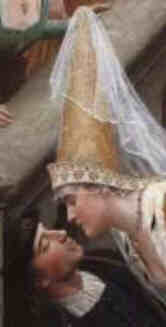 Un grand événement historique influença plus particulièrement son
oeuvre: la bataille d’Azincourt (1415), qui engendra l’un de ses plus
longs poèmes (3600 vers): Le Livre des Quatre Dames (1416),
poème octosyllabique dont le thème principal en est les malheurs de
quatre femmes qui s’interrogent sur leurs destins respectifs et se
demandent lequel est le plus douloureux: l’amant de la première dame
est mort, celui de la deuxième dame fut capturé, le suivant disparaît
et le dernier a déserté le champ de bataille par lâcheté. Cette oeuvre
remporta un vif succès et influença la littérature du XVIe siècle,
notamment Marguerite d’Angoulême qui s’en inspira dans La Coche.
Un grand événement historique influença plus particulièrement son
oeuvre: la bataille d’Azincourt (1415), qui engendra l’un de ses plus
longs poèmes (3600 vers): Le Livre des Quatre Dames (1416),
poème octosyllabique dont le thème principal en est les malheurs de
quatre femmes qui s’interrogent sur leurs destins respectifs et se
demandent lequel est le plus douloureux: l’amant de la première dame
est mort, celui de la deuxième dame fut capturé, le suivant disparaît
et le dernier a déserté le champ de bataille par lâcheté. Cette oeuvre
remporta un vif succès et influença la littérature du XVIe siècle,
notamment Marguerite d’Angoulême qui s’en inspira dans La Coche.
Reprenant les thèmes du lyrisme
courtois, il publie ensuite la Belle Dame sans mercy, 1424, son poème
le plus célèbre, qui est en fait un pamphlet humoristique sur la trop
grande sévérité des femmes et qui retrace les paroles d’un soupirant
mal aimé à sa dame dont la froideur inspire des vers parmi les plus
célèbres de la poésie française. S’il s’agit d’un thème conventionnel
de l’amour courtois à la fin du Moyen Âge, la dextérité de la forme
distingue Alain Chartier des écrivains de son temps et a fait de ce
poème l’un des plus connus à l’étranger de la littérature française.
Souvent imitée au Moyen Âge, cette oeuvre renforça encore la notoriété
de Chartier, au point qu'elle inspira le poète anglais John Keats,
qui composa, quatre siècles plus tard, un poème portant le même titre.
Le poète anglais qui avait pris ce titre d’un poème attribué par erreur
à Chaucer et sa «Belle Dame sans merci» se révèle assez différent
du poème de Chartier qui fit de ce dernier le maître du huitain.
Mais, Alain Chartier n'est pas seulement
poète: on l’admire aussi pour sa prose soignée, écrite en français
et en latin, à tel point que Pasquier lui donna le titre de «Sénèque
de la France». La perfection de sa prose est telle, qu’au XVIIe siècle
un maître de la langue française, Charles Sorel, déclarera qu’il la
préfére à ses poèmes.
On lui
doit le fameux Quadrilogue invectif (1422), allégorie politique
en prose dans laquelle la France supplie ses trois enfants (le Peuple,
le Chevalier et le Clergé) de se réconcilier pour son propre salut
et qui n'est autre qu'un vibrant appel à l'unité de la nation française.
Chartier est également l'auteur d'une lettre en latin envoyée en 1429
à un prince étranger, dans laquelle il célèbre les mérites et la gloire
de Jeanne d'Arc. Ses deux formes d’expression, prose et poésie, ont
en tout cas profondément influencé la création littéraire du XVe siècle,
notamment l’art des rhétoriqueurs qui le considéraient comme le père
de l’élégance française: «noble poète et orateur», comme le précise
Jean Lemaire de Belges.
Alain
Chartier ne se contentera pas de marquer la littérature française
par ses écrits, il le fit également par le mythe qui entoura sa vie.
Ce mythe – l’histoire du fameux baiser qu’aurait laissé Marguerite
d’Écosse sur les lèvres de Chartier, faisant jaillir ainsi toute la
création poétique de sa bouche – est repris au XIXe siècle par de
grands écrivains tels Gérard
de Nerval et Alfred
de Musset.
Bien qu'elle soit
apocryphe, la célèbre anecdote de Jean Bouchet sert à indiquer la
renommée dont jouissait Chartier à l'époque. D'après celui-là, la
dauphine Marguerite d'Écosse aurait un jour embrassé Alain Chartier
qui dormait sur un banc. Elle s'expliqua en disant : « Je n'ay pas
baisé l'homme, mais la precieuse bouche de laquelle sont yssuz et
sortis tant de bons mots et vertueuses parolles ». Mots à retenir,
même si Marguerite n'arriva en France qu'en 1436, six ans après la
mort du poète.
La Belle Dame sans mercy
(début) |
Naguère, chevauchant, pensaie
Comme homme triste et douloureux,
Au deuil où il faut que je soie
Le plus dolent des amoureux,
Puisque, par son dard rigoureux,
La mort me tollit ma maîtresse
Et me laissa seul, langoureux
En la conduite de Tristesse.
Si disais : « Il faut que je cesse
De dicter et de rimoyer,
Et que j'abandonne et délaisse
Le rire pour le larmoyer.
Là me faut le temps employer,
Car plus n'ai sentiment ni aise,
Soit d'écrire, soit d'envoyer
Chose qu'à moi ni autre plaise.
Qui voudrait mon vouloir contraindre
À joyeuses choses écrire,
Ma plume n'y saurait atteindre,
Non ferait ma langue à les dire.
Je n'ai bouche qui puisse rire
Que les yeux ne la démentissent,
Car le coeur l'envoirait dédire
Par les larmes qui des yeux issent.
Je laisse aux amoureux malades
Qui ont espoir d'allégement
Faire chansons, dits et ballades,
Chacun à son entendement,
Car ma dame en son testament
Prit à la mort, Dieu en ait l'âme,
Et emporta mon sentiment
Qui gît o elle sous la lame.
Désormais est temps de moi taire,
Car de dire suis-je lassé.
Je veux laisser aux autres faire :
Leur temps est ; le mien est passé.
Fortune a le forcier cassé
Où j'épargnaie ma richesse
Et le bien que j'ai amassé
Au meilleur temps de ma jeunesse.
Amour a gouverné mon sens :
Si faute y a, Dieu me pardonne ;
Si j'ai bien fait, plus ne m'en sens,
Cela ne me toult ni me donne,
Car au trépas de la très-bonne
Tout mon bienfait se trépassa.
La mort m'assit illec la borne
Qu'oncques plus mon coeur ne passa. » |
En ce penser et en ce soin
Chevauchai toute matinée,
Tant que je ne fus guère loin
Du lieu où était la dînée ;
Et quand j'eus ma voie finée
Et que je cuidai héberger,
J'ouïs par droite destinée
Les ménétriers en un verger.
Si me retrahis volontiers
En un lieu tout coi et privé,
Mais quand mes bons amis entiers
Surent que je fus arrivé,
Ils vinrent. Tant ont étrivé,
Moitié force, moitié requête,
Que je n'ai oncques esquivé
Qu'ils ne me mènent à la fête.
À l'entrer fus bien
recueilli
Des dames et des demoiselles,
Et de celles bien accueilli
Qui toutes sont bonnes et belles ;
Et de la courtoisie d'elles
Me tinrent illec tout le jour
En plaisant paroles nouvelles
Et en très-gracieux séjour.
Dîner fut prêt et tables mises.
Les dames à table s'assirent
Et quand elles furent assises,
Les plus gracieux les servirent.
Tels y eut qui à ce jour virent
En la compagnie liens
Leurs juges, dont semblant ne firent,
Qui les tiennent en leurs liens.
Un entre les autres y vis,
Qui souvent allait et venait,
Et pensais comme homme ravi
Et guère de bruit ne menait.
Son semblant fort contretenait ;
Mais Désir passait la raison,
Qui souvent son regard menait
Tel fois qu'il n'était pas saison.
De faire chère s'efforçait
Et menait une joie feinte,
Et à chanter son coeur forçait
Non pas pour plaisir mais pour crainte,
Car toujours un relais de plainte
S'enlaçait au son de sa voix ;
Et revenait à son atteinte
Comme l'oisel au chant du bois. |
Des autres y eut pleine salle,
Mais celui trop bien me semblait
Ennuyé, maigre, blême et pâle,
Et la parole lui tremblait.
Guères aux autres n'assemblait ;
Le noir portait et sans devise,
Et trop bien homme ressemblait
Qui n'a pas son coeur en franchise.
De toutes festoyer feignait,
Bien le fit et bien lui seyait ;
Mais à la fois le contraignait
Amour qui son coeur hardoyait
Pour sa maîtresse qu'il voyait,
Que je choisis lors clairement
À son regard qu'il assoyait
Sur elle si piteusement.
Assez sa face détournait
Pour regarder en autres lieux,
Mais au travers l'oeil retournait
Au lieu qui lui plaisait le mieux.
J'aperçus le trait de ses yeux,
Tout empenné d'humbles requêtes ;
Si dis à part moi : « Si m'aid' Dieux,
Autel fumes comme vous êtes ».
À la fois à part
se tirait
Pour raffermir sa contenance,
Et très-tendrement soupirait
Par douloureuse souvenance.
Puis reprenait son ordonnance
Et venait pour servir les mets,
Mais à bien juger sa semblance,
C'était un piteux entremets.
Après dîner on s'avança
De danser, chacun et chacune,
Et le triste amoureux dansa
Adès o l'autre, adès o l'une.
À toutes fit chère commune,
Ô chacune à son tour allait ;
Mais toujours retournait à une
Dont sur toutes plus lui chalait.
[...]
|
1413 Henry IV, king of England. He is
succeded by his eldest son, Henry V.
1191 Clemente
III, papa.
|
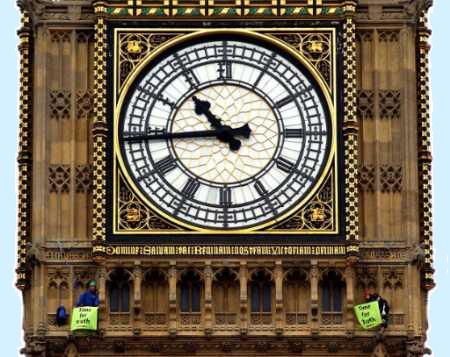 On
a March 20:
On
a March 20:  2004
Taiwan's President Chen Shui-bian “A-bian”, 53, and Vice President
Annette Lu, both of the Democratic Progressive Party, are reelected with
50.1% of the votes cast by the 80% of the electorate that voted [< the two,
celebrating, behind bullet-proof glass]. The previous day, at midday, the
two were riding in an open Jeep in Tainan, when a bullet wounded Chen in
the abdomen and another bullet wounded Lu in the knee. Whoever shot at them
was not caught. The opposition Nationalist Party suggests that the attack
was a fake intended to gain sympathy votes, and its presidential candidate,
Lien Chan, 67, demands the annulation of the vote (of which he got 49.9%).
Lien is gratified however by the success of his call to boycott as illegal
a referendum conducted at the same time as the election: it ends up invalid
because less than 50% (45% in fact) of eligible voters participated in it,
92% of those voting answering "yes" to both questions: Should
Taiwan's defenses be strengthened if China refuses to redeploy hundreds
of missiles pointed at it?; Should Taiwan seek talks with China about setting
up a new "peace and stability framework."? Former political science
professor Lien, who belongs to one of Taiwan's richest families, served
as an ambassador, foreign minister, premier, and vice president in the former
Nationalist government. Chen grew up in a poor village and graduated from
Taiwan's top law school. He got into politics by defending dissidents during
the Nationalists' martial law era, which ended in 1987. He has been a legislator
and Taipei mayor. Neither candidate favors immediate unification with China,
and both deeply distrust its Communist leadership. But Chen has been more
aggressive in pushing for a Taiwanese identity separate from China, raising
tensions with the Beijing regime.
2004
Taiwan's President Chen Shui-bian “A-bian”, 53, and Vice President
Annette Lu, both of the Democratic Progressive Party, are reelected with
50.1% of the votes cast by the 80% of the electorate that voted [< the two,
celebrating, behind bullet-proof glass]. The previous day, at midday, the
two were riding in an open Jeep in Tainan, when a bullet wounded Chen in
the abdomen and another bullet wounded Lu in the knee. Whoever shot at them
was not caught. The opposition Nationalist Party suggests that the attack
was a fake intended to gain sympathy votes, and its presidential candidate,
Lien Chan, 67, demands the annulation of the vote (of which he got 49.9%).
Lien is gratified however by the success of his call to boycott as illegal
a referendum conducted at the same time as the election: it ends up invalid
because less than 50% (45% in fact) of eligible voters participated in it,
92% of those voting answering "yes" to both questions: Should
Taiwan's defenses be strengthened if China refuses to redeploy hundreds
of missiles pointed at it?; Should Taiwan seek talks with China about setting
up a new "peace and stability framework."? Former political science
professor Lien, who belongs to one of Taiwan's richest families, served
as an ambassador, foreign minister, premier, and vice president in the former
Nationalist government. Chen grew up in a poor village and graduated from
Taiwan's top law school. He got into politics by defending dissidents during
the Nationalists' martial law era, which ended in 1987. He has been a legislator
and Taipei mayor. Neither candidate favors immediate unification with China,
and both deeply distrust its Communist leadership. But Chen has been more
aggressive in pushing for a Taiwanese identity separate from China, raising
tensions with the Beijing regime. 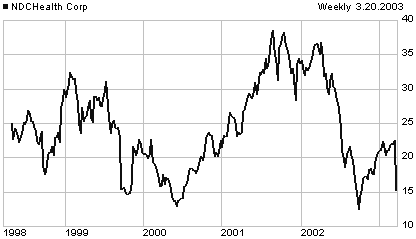 2003
The previous evening, NDCHealth (NDC) forecast lower than expected earnings
for 2003 and announced that for the quarter ended on 28 Feb 2003 it had
losses of $0.11 per share (in the same quarter a year earlier they had earnings
of $0.31 per share). NDC is downgraded by Bear Sterns from Peer Perform
to Underperform. On the New York Stock Exchange, 7.4 million of the 35 million
NDC shares are traded, dropping from their previous close of $22.48 to an
intraday low of $14.47 and closing at $15.05. They had traded as low as
$10.90 as recently as 07 October 2003; and as high as $38.66 on 27 August
2001. [5~year price chart >] NDC is a network-based company
that provides healthcare information services to pharmacies, physicians,
payers and pharmaceutical manufacturers.
2003
The previous evening, NDCHealth (NDC) forecast lower than expected earnings
for 2003 and announced that for the quarter ended on 28 Feb 2003 it had
losses of $0.11 per share (in the same quarter a year earlier they had earnings
of $0.31 per share). NDC is downgraded by Bear Sterns from Peer Perform
to Underperform. On the New York Stock Exchange, 7.4 million of the 35 million
NDC shares are traded, dropping from their previous close of $22.48 to an
intraday low of $14.47 and closing at $15.05. They had traded as low as
$10.90 as recently as 07 October 2003; and as high as $38.66 on 27 August
2001. [5~year price chart >] NDC is a network-based company
that provides healthcare information services to pharmacies, physicians,
payers and pharmaceutical manufacturers. 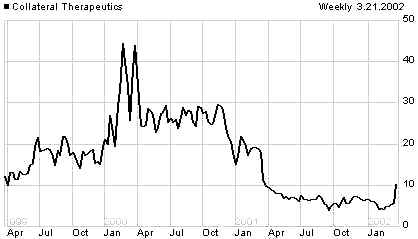 2002
The stock of Collateral Therapeutics Inc. (CLTX) rises 104% on the NASDAQ,
from the previous close of $5.09 to close at $10.37, while the company is
still losing money. It had traded as low as $2.81 on 21 Sep 2001, and as
high as $44.38 on 21 February 2000. [< 3-year stock price graph]
On 20 March 2003 CLTX, now delisted, would be at $10.77 Over-the-Counter.
2002
The stock of Collateral Therapeutics Inc. (CLTX) rises 104% on the NASDAQ,
from the previous close of $5.09 to close at $10.37, while the company is
still losing money. It had traded as low as $2.81 on 21 Sep 2001, and as
high as $44.38 on 21 February 2000. [< 3-year stock price graph]
On 20 March 2003 CLTX, now delisted, would be at $10.77 Over-the-Counter.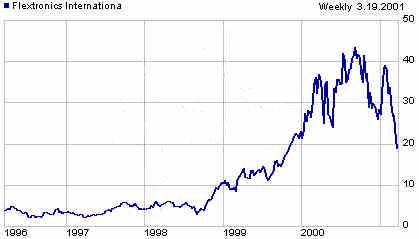 2001
Stock of the semiconductor company Flextronics International (FLEX on NASDAQ)
drops $4.38 to close at $19.00, having traded as low as $18.19 during the
day, its lowest since 1999. [5-year stock price graph >].
On 20 March 2002 it would close at $16.61, after having traded as low as
$12.38 on 04 April 2001, and as high as $ 33.09 on 21 May 2001. On
20 March 2003 it would close at $9.49, having traded as high as $18.98 on
01 April 2002 and as low as $5.47 on 09 October 2002.
2001
Stock of the semiconductor company Flextronics International (FLEX on NASDAQ)
drops $4.38 to close at $19.00, having traded as low as $18.19 during the
day, its lowest since 1999. [5-year stock price graph >].
On 20 March 2002 it would close at $16.61, after having traded as low as
$12.38 on 04 April 2001, and as high as $ 33.09 on 21 May 2001. On
20 March 2003 it would close at $9.49, having traded as high as $18.98 on
01 April 2002 and as low as $5.47 on 09 October 2002. Deaths
Deaths 2004
2004

